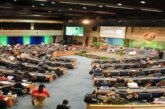United Nations Environmental Programme
| This report provides the bedrock for hope. By bringing together the latest scientific evidence showing the impacts and threats of the climate emergency, the biodiversity crisis and the pollution that kills millions of people every year, it makes clear that our war on nature has left the planet broken. But it also guides us to a safer place by providing a peace plan and a post-war rebuilding programme. By transforming how we view nature, we can recognize its true value. – António Guterres -SecretaryGeneral of the United Nations |

The current pace that the world is developing has a detrimental effect on its natural systems. Over the last 50 years, the global economy has grown nearly fivefold, due largely to a tripling in extraction of natural resources and energy that has fuelled growth in production and consumption. The world population has increased by a factor of two, to 7.8 billion people, and though on average prosperity has also doubled, about 1.3 billion people remain poor and some 700 million are hungry. Due to the over use of our natural resources, there has been extreme events happening like climate change, biodiversity loss, pollution and resource degradation. Social, economic and financial systems fail to account for the essential benefits society gets from nature and to pro-vide incentives to manage it wisely and maintain its value.
Sustainable development goals, Biodiversity conservation, Climate change, Land degradation, Climate change, Biodiversity loss, Pollution
Current and projected changes in climate, biodiversity loss and pollution makes achieving the SDGs even more challenging. For example, even small increases in temperature, along with associated changes such as in weather, precipitation, heavier rainfall events, extreme heat, drought and fire, increase risks to health, food security, water supply and human security, and these risks increase along with warming.
| Humanity’s environmental challenges have grown in number and severity ever since the Stockholm Conference in 1972 and now represent a planetary emergency. While tackling the emergency is demanding, this report, Making Peace with Nature, lights a path to a sustainable future with new possibilities and opportunities |
In 2018 alone, damages from climate-related natural disasters cost about US$155 billion. The deteriorating state of the planet undermines efforts to achieve healthy lives and well-being for all. Around one quarter of the global burden of disease stems from environment-related risks, including those from animal-borne diseases (such as COVID-19), climate change, and exposure to pollution and toxic chemicals. Pollution causes some 9 million premature deaths annually and millions more die every year from other environment-related health risks.
The risks to human well-being and the achievement of the Sustainable Development Goals will continue to esca-late unless environmental degradation is halted. Global warming of more than 2°C combined with continued loss of biodiversity and increasing pollution will likely have dire consequences for humanity. The costs of inaction on limiting environmental change far outweigh the costs of action. Global aggregate impacts from climate change are estimated to be very high by the end of the century unless cost-effective mitigations strategies are undertaken.
Transforming human’s relationship with nature is paramount to a sustainable future. Only a system-wide transformation will achieve well-being for all within the Earth’s capacity to support life, provide re-sources and absorb waste. This transformation will involve a fundamental change in the technological, economic and social organization of society, including world views, norms, values and governance.
Major shifts in investment and regulation are key to just and informed transformations that overcome inertia and opposition from vested interests. Regulatory processes should embody transparent decision-making and good governance involving all relevant stakeholders. Opposition to change can be defused by redirecting subsidies toward alternative livelihoods and new business models.

The COVID-19 crisis provides an impetus to accelerate transformative change. The pandemic and the ensuing economic upheaval have shown the dangers of ecosystem degradation, as well as the need for international cooperation and greater social and economic resilience. The crisis has had major economic costs and is triggering significant investments. Ensuring that these investments support transformative change is key to attaining sustainability.
Given the interconnected nature of climate change, loss of biodiversity, land degradation, and air and water pollution, it is essential that these problems are tackled together. Response options that address multiple issues can mitigate multidimensional vulnerability, minimize trade-offs and maximize synergies. Limiting global warming to well below 2°C above pre-industrial levels and pursuing efforts to further limit the temperature increase to 1.5°C requires rapid implementation and a significant strengthening of pledges under the Paris Agreement. Globally, net carbon dioxide emissions need to decline by 45 per cent by 2030 compared with 2010 levels and reach net zero by 2050 to put the world on a pathway to 1.5°C with a probability of about 50 per cent, whereas more ambitious targets would be necessary for higher certainty.

Governments should incorporate full natural capital ac-counting into their decision-making and use policies and regulatory frameworks to provide incentives for businesses to do the same. Governments should shift away from environmentally harmful subsidies, invest in low-carbon and nature-friendly solutions and technologies, and systematically internalize environmental and social costs. A One Health approach integrates action across sectors and disciplines to protect the health of people, animals and the environment. Such an approach is key to minimize future human health risks from climate change, ecosystem degradation and deteriorating food, air and water quality. It is also essential in preventing and limiting the impact of future health emergencies, including pandemic outbreaks of animal-borne diseases such as COVID-19.
We all have a part to play in bringing together transformative change with an immediate and long term impact. This can be enhanced through capacity-building and education. Governments initiate and lead in intergovernmental cooperation, policies and legislation that transform society and the economy. Such transformations enable the private sector, financial institutions, labour organizations, scientific and educational bodies and media as well as households and civil society groups to initiate and lead transformations in their domains. Individuals can facilitate transformation by, for instance, exercising their voting and civic rights, changing their diets and travel habits, avoiding waste of food and resources, and reducing their consumption of water and energy. They can also promote behavioural change by raising awareness in their communities. Human cooperation, innovation and knowledge-sharing will create new social and economic possibilities and opportunities in the transformation to a sustainable future.
Download full report from the website: https://www.unep.org/resources/making-peace-nature
References of work:
https://www.international-climate-initiative.com/en/news/article/making_peace_with_nature
https://www.cbd.int/article/making-peace-with-nature



